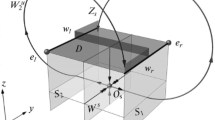Abstract
The qualitative theory of nonlinear spatial dynamical systems has attracted increasing attention recently. In particular, we have studied construction of spatial periodic orbits, dynamical behaviors of spatial chaos in the sense of Li–Yorke–Marotto, spatial Lyapunov exponents, control and generalized synchronization of spatial chaotic systems. In this paper, we apply a special mathematical transform to obtain spatial chaos on surface and its associated bifurcation and Feigenbaum problem. The 2D Logistic system is used for illustration. In addition, we also illustrate the difference in essence about chaos on surface as high-dimensional spatial system and dimension in phase space and we also analyze the parallel and different characters of theory system between 1D and 2D Logistic system.


















Similar content being viewed by others
References
Winfree, A.T.: Scroll-shaped wave of chemical activity in three dimensions. Science 181, 937–939 (1973)
May, R.M.: Simple mathematical models with very complex dynamics. Science 186, 645–647 (1974)
Grebogi, C., Ott, E., Yorke, J.A.: Chaos, strange attractors, and fractal basin boundaries in nonlinear dynamics. Science 238, 632–638 (1987)
Pool, R.: Putting chaos to work. Science 250, 626–628 (1990)
Ottino, J.M., Muzzio, F.J., Tjahjadi, M., Franjione, J.G., Jana, S.C., Kusch, H.A.: Chaos, symmetry, and self-similarity: exploiting order and disorder in mixing processes. Science 257, 754–760 (1992)
Henson, S.M., Costantino, R.F., Cushing, J.M., Desharnais, R.A., Dennis, B., King, A.A.: Lattice effects observed in chaotic dynamics of experimental populations. Science 294, 602–605 (2001)
Otto, E.R., Klaus, W.: Chaos in the Zhabotinskii reaction. Nature 271, 89–90 (1978)
Juckes, M.N., Mclntyre, M.E.: A high-resolution one-layer model of breaking planetary waves in the stratosphere. Nature 328, 590–596 (1987)
Petrov, V., Gaspar, V., Masere, J., Showalter, K.: Controlling chaos in the Belousov–Zhabotinsky reaction. Nature 361, 240–246 (1993)
Schiff, S.J., Jerger, K., Duong, D.H., Chang, T., Spano, M.L., Ditto, W.L.: Controlling chaos in the brain. Nature 370, 615–621 (1994)
Paul, M.: Models for material failure and deformation. Science 252, 226–234 (1991)
Bertram, E.S., Chua, L.O.: Resistive grid image filtering: input/output analysis via the CNN Framework. IEEE Trans. Circuits Syst. I 39, 531–548 (1999)
Li, X.P.: Partial difference equations used in the study of molecular orbits. Acta Chim. SINICA 40, 688–698 (1982)
Liu, S.T., Wang, H.: Necessary and sufficient conditions for oscillations of a class of delay partial difference equations. Dyn. Syst. Appl. 7, 495–500 (1998)
Liu, S.T., Guan, X.P., Yang, J.: Nonexistence of positive solution of a class of nonlinear delay partial difference equation. J. Math. Anal. Appl. 234, 361–371 (1999)
Liu, S.T., Liu, Y.Q.: Oscillation theorems for second-order nonlinear partial difference equations. J. Comput. Appl. Math. 132, 479–482 (2001)
Liu, S.T., Liu, Y.Q.: Oscillation for nonlinear partial difference equation with positive and negative coefficients. Comput. Math. Appl. 43, 1219–1230 (2002)
Chen, G., Liu, S.T.: On spatial periodic orbits and spatial chaos. Int. J. Bifurc. Chaos 13, 935–941 (2003)
Hao, B.L.: Symbolic dynamics and chaos in dissipative systems. World Scientific, Singapore (1989)
Kaneko, K.: Complex systems: chaos and beyond. Asakura Publishing Co., Ltd, Tokyo (1996)
Pecora, L.M., Carroll, T.L.: Synchronization in chaotic systems. Phys. Rev. Lett. 64, 821–824 (1990)
He, R., Vaidya, P.G.: Analysis and synthesis of synchronous periodic and chaotic systems. Phys. Rev. E 46, 7387–7392 (1992)
Nikolai, F.R., Mikhai, M.S., Lev, S.T.: Generalized synchronization of chaos in directionally coupled chaotic systems. Phys. Rev. E 51, 980–994 (1995)
Parlitz, U., Junge, L., Kocarev, L.: Subharmonic entrainment of unstable period orbits and generalized synchronization. Phys. Rev. Lett. 79, 3158–3161 (1997)
Brown, R., Kocarev, L.: A unifying definition of synchronization for dynamical systems. Chaos 10, 344–349 (2000)
Junge, L., Ulrich, P.: Synchronization using dynamic coupling. Phys. Rev. E 64, 2041–2044 (2001)
Liu, S.T., Chen, G.: Asymptotic behavior of delay 2-D discrete logistic systems. IEEE Trans. Circuits Syst. I Fundam. Theory Appl. 49, 1677–1682 (2002)
Liu, S.T., Chen, G.: Nonlinear feedback-controlled generalized synchronization of spatial chaos. Chaos Solitons Fractals 22, 35–46 (2002)
Liu, S.T., Chen, G.: On spatial Lyapunov exponents and spatial chaos. Int. J. Bifurc. Chaos 13, 1163–1181 (2003)
Chen, G., Liu, S.T.: On generalized synchronization of spatial chaos. Chaos Solitons Fractals 15, 311–318 (2003)
Devaney, R.L.: A first course in chaotic dynamical systems: theory and experiment, pp. 39–93. Westview Press, New York (1992)
Liu, S.T., Wu, S.T.: Uniformity of spatial physical motion systems and spatial chaos behavior in the sense of Li–York. Int. J. Bifurc. Chaos Appl. Sci. Eng. 16, 2697–2703 (2006)
Liu, S.T.: Nuclear fission and spatial chaos. Chaos Solitons Fractals 30, 453–462 (2006)
Liu, S.T., Wu, S.T.: Spacial chaos behavior of molecular orbit. Chaos Solitons Fractals 31, 1181–1186 (2007)
Lorenz, E.N.: Deterministic nonperiodic flow. J. Atmos. Sci. 20, 130–141 (1963)
Chen, G., Veta, T.: Yet another chaotic attractor. Int. J. Bifurc. Chaos 9, 1465–1466 (1999)
Lu, H., Chen, G.: A new chaotic attractor coined. Int. J. Bifurc. Chaos 12, 659–661 (2002)
Rossler, O.E.: An equation for continuous chaos. Phys. Lett. A 57, 397–398 (1976)
Russel, D.A., Hanson, J.D., Ott, E.: Dimension of strange attractors. Phys. Rev. Lett. 45, 1175 (1980)
Chen, A., Lu, J., Yu, S.: Generating hyperchaotic L\(\ddot{u}\) attractor via state feedback control. Phys. A 364, 103–110 (2006)
Acknowledgments
Thank you for reviewer’s valuable suggestions. The work was supported by the Natural Science Foundation Project (Nos.31301080, 61273088 and 10971120), National Key Technology Support Program (No. 2015BAF13B00) and the Open Project of State Key Laboratory of Crop Biology (No. 2013KF10).
Author information
Authors and Affiliations
Corresponding author
Rights and permissions
About this article
Cite this article
Liu, S., Liu, P., Liu, J. et al. Spatial chaos on surface and its associated bifurcation and Feigenbaum problem. Nonlinear Dyn 81, 283–298 (2015). https://doi.org/10.1007/s11071-015-1991-7
Received:
Accepted:
Published:
Issue Date:
DOI: https://doi.org/10.1007/s11071-015-1991-7




